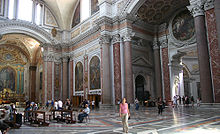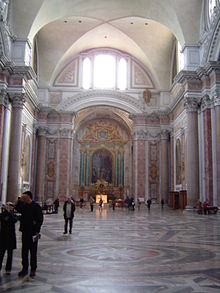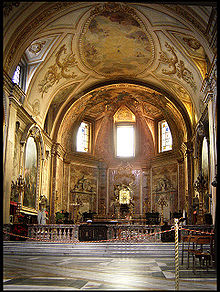- Santa Maria degli Angeli e dei Martiri
-
Basilica of St. Mary of the Angels and the Martyrs
Santa Maria degli Angeli e dei Martiri (Italian)
Beatissimae Virginis et omnium Angelorum et Martyrum (Latin)
Church facade is the ancient frigidarium of the Baths of Diocletian
Basic information Location  Rome, Italy
Rome, ItalyGeographic coordinates 41°54′11″N 12°29′49″E / 41.90306°N 12.49694°ECoordinates: 41°54′11″N 12°29′49″E / 41.90306°N 12.49694°E Affiliation Roman Catholic Ecclesiastical or organizational status Minor basilica Leadership William Henry Keeler Website Official website Architectural description Architect(s) Michelangelo Buonarroti, Luigi Vanvitelli Architectural type Church Architectural style Baroque Direction of façade SW Groundbreaking 1562 Specifications Length 128 metres (420 ft) Width 105 metres (344 ft) Width (nave) 25 metres (82 ft) The Basilica of St. Mary of the Angels and the Martyrs (Latin: Beatissimae Virgini et omnium Angelorum et Martyrum, Italian: Santa Maria degli Angeli e dei Martiri) is a titular basilica church in Rome, built inside the frigidarium of the Baths of Diocletian. The Cardinal priest of the Titulus S. Mariae Angelorum in Thermis is William Henry Keeler.
Contents
The basilica
The basilica is dedicated to the Christian martyrs, known and unknown.[1] It was also a personal monument of Pope Pius IV, whose tomb is in the apsidal tribune that culminates the series of spaces.
The thermae of Diocletian dominated the Quirinal Hill with their ruined mass and had successfully resisted Christianization. Michelangelo Buonarroti worked from 1563 to 1564 to adapt a section of the remaining structure of the baths to enclose a church. Some later construction directed by Luigi Vanvitelli in 1749 only superficially distracts from the grand and harmonious Michelangelesque volumes. At Santa Maria degli Angeli, Michelangelo achieved an unexampled sequence of shaped architectural spaces with few precedents or followers. There is no true facade (illustration); the simple entrance is set within one of the coved apses of a main space of the thermae. The plan is developed from a Greek cross, with a transept so dominant, with its cubical chapels at each end, that the effect is of a transverse nave.
The vestibule with canted corners and identical side chapels[2] leads to a second vestibule, repeated on the far side of the transept, dominated by the over lifesize Saint Bruno of Cologne by Jean Antoine Houdon (1766).[3] The great vaulted transept gives a striking display of the magnificent scale of Roman constructions, 90.8 meters long, and with the floor that Michelangelo raised to bring it up to the Seicento street level, 28 meters high. Raising the floor truncated the red granite Roman columns (illustration on left) that articulate the transept and its flanking spaces. Michelangelo made the transept 27 meters wide, thus providing vast cubical spaces at each end of the transept.
In 2006, Polish-born sculptor Igor Mitoraj created new bronze doors as well as a statue of John the Baptist for the basilica.
In April 2010, a five metre high bronze statue of Galileo Galilei Divine Man (designed by 1957 Nobel laureate Tsung-Dao Lee) was unveiled in a courtyard within the complex. The statue (a dedication to the 17th century scientist and philosopher) was a donation from CCAST (China Center of Advanced Science and Technology) and WFS (World Federation of Scientists).
Santa Maria degli Angeli was the official state church during the Kingdom of Italy (1870-1946). More recently, national burials have been held in the church. The church hosts the tombs of General Armando Diaz and Admiral Paolo Thaon di Revel, who were the commanders responsible for winning World War I on the Italian front.Also today the Basilica is used for many ceremonies, included the funeral of soldiers killed aboard.William Henry Keeler is the Cardinal Priest of the Titulus S. Mariae Angelorum in Thermis.
The meridian line
At the beginning of the eighteenth century, Pope Clement XI commissioned the astronomer, mathematician, archaeologist, historian and philosopher Francesco Bianchini to build a meridian line, a sort of sundial, within the basilica. Completed in 1702, the object had a threefold purpose: the pope wanted to check the accuracy of the Gregorian reformation of the calendar, to produce a tool to predict Easter exactly, and, not least, to give Rome a meridian line as important as the one Giovanni Domenico Cassini had recently built in Bologna's cathedral, San Petronio.[4] This church was chosen for several reasons: (1) Like other baths in Rome, the building was already naturally southerly oriented, so as to receive unobstructed exposure to the sun; (2) the height of the walls allowed for a long line to measure the sun's progress through the year more precisely; (3) the ancient walls had long since stopped settling into the ground, ensuring that carefully calibrated observational instruments set in them would not move out of place; and (4) because it was set in the former baths of Diocletian, it would symbolically represent a victory of the Christian calendar over the earlier pagan calendar.
 Diagram of Bianchini's meridian in Santa Maria degli Angeli e dei Martiri, from his De Calendario... (1703). The ray on the right comes from the sun, and hits the line at solar noon through the year. The ray on the left is from Polaris.
Diagram of Bianchini's meridian in Santa Maria degli Angeli e dei Martiri, from his De Calendario... (1703). The ray on the right comes from the sun, and hits the line at solar noon through the year. The ray on the left is from Polaris.
Bianchini's sundial was built along the meridian that crosses Rome, at longitude 12° 30' E. At solar noon, which varies according to the equation of time from around 10:54 a.m. UTC in late October to 11.24 a.m. UTC in February (11:54 to 12:24 CET), the sun shines through a small hole in the wall to cast its light on this line each day. At the summer solstice, the sun appears highest, and its ray hits the meridian line at the point closest to the wall. At the winter solstice, the ray crosses the line at the point furthest from the wall. At either equinox, the sun touches the line between the these two extremes. The longer the meridian line, the more accurately the observer can calculate the length of the year. The meridian line built here is 45 meters long and is composed of bronze, enclosed in yellow-white marble.
In addition to using the line to measure the sun's meridian crossing, Bianchini also added holes in the ceiling to mark the passage of stars. Inside the interior, darkened by covering the windows, Polaris, Arcturus and Sirius were observed through these holes with the aid of a telescope to determine their right ascensions and declinations.[5] The meridian line was restored in 2002 for the tricentenary of its construction, and it is still operational today.
Cardinal Protectors of Santa Maria degli Angeli e dei Martiri since 1844
- Domenico Carafa della Spina di Traetto (22 Jul 1844 - 12 May 1879)
- Lajos Haynald (12 May 1879 - 4 Jul 1891 )
- Anton Joseph Gruscha (1 Jun 1891 - 15 Aug 1911 )
- Gennaro Granito Pignatelli di Belmonte (27 Nov 1911 - 6 Dec 1915)
- Alfonso Mistrangelo, Sch. P. (6 Dec 1915 - 7 Nov 1930)
- Jean-Marie-Rodrigue Villeneuve, O.M.I. (13 Mar 1933 - 17 Jan 1947 )
- Paul-Émile Léger, P.S.S. (12 Jan 1953 - 13 Nov 1991 )
- William Keeler (26 Nov 1994 - )
Burials
Notes
- ^ By a brief dated 27 July 1561, Pius IV ordered the church "built", to be dedicated to the Beatissimae Virgini et omnium Angelorum et Martyrum ("the Most Blessed Virgin and all the Angels and Martyrs"); impetus for this dedication had been generated by the account of a vision experienced in the ruins of the Baths in 1541 by a Sicilian monk, Antonio del Duca, who had been lobbying for decades for papal authorization of a more formal veneration of the Angelic Princes. A story that these Martyrs were Christian slave labourers who had been set to constructing the Baths is modern.
- ^ One chapel has the tomb of Salvator Rosa, the other of Carlo Maratta.
- ^ Of Houdon's Saint Bruno Clement XIV said that he would speak, were it not for the vow of silence of the order he founded.
- ^ In fact, Alan Cook remarked, "The disposition, the stability and the precision are much better than those of the famous meridian... in Bologna". (Alan Cook, "A Roman Tercentenary" Notes and Records of the Royal Society of London 56,3 (September 2002), p. 273.)
- ^ "osservazione_stelle ITALIANO" (in Italian). Basilica S. Maria degli Angeli e dei Martiri. http://www.santamariadegliangeliroma.it/dettagliofotosing.html?chiave=8463&lingua=ITALIANO&ramo_home=La_Meridiana&codice_url=osservazione_stelle. Retrieved 2009-09-29. "La stella veniva osservata con un telescopio portatile posto sulla Linea."
References
- Ackerman, James S., The Architecture of Michelangelo 2nd. ed. 1964:136-41.
- Blavatsky, Helena P., "Star-Angel-Worship in the Roman Catholic Church", in Lucifer magazine, July 1888 on-line text
- Karmon, David, "Michelangelo's "Minimalism" in the Design of Santa Maria degli Angeli", in Annali di Architettura n° 20, Vicenza 2008 on-line text
- Touring Club Italiano (TCI) Roma e Dintorni 1965:317f.
External links
- Santa Maria degli Angeli e dei Martiri alle Terme di Diocleziano official website.
- Flickr
- Titulus (St. Mary of the Angels) ... (history of)
Categories:- Basilica churches in Rome
- Titular churches in Rome
- Burial places of popes
- 19th-century church buildings
Wikimedia Foundation. 2010.




